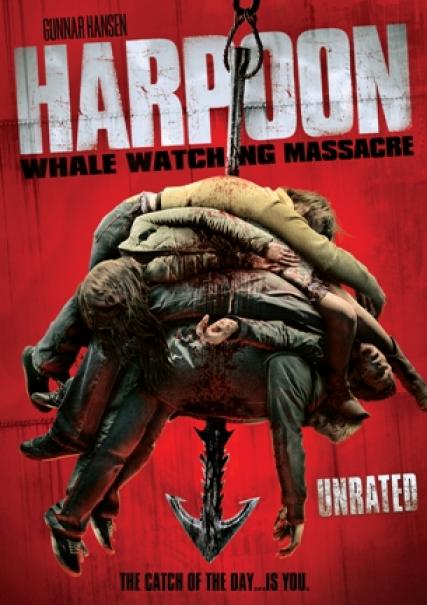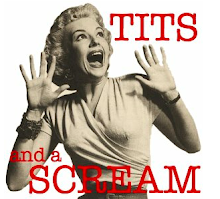As you can see from even the namedropping in the trailer (In the tradition of The Hills Have Eyes and The Texas Chain Saw Massacre!), it's not only in its name that Harpoon: The Reykjavík Whale Watching Massacre tries to live up to Tobe Hooper's 1974 classic. Does it pull it off, you ask? Well, my introductory disclaimer might give you a hint...
Of course, I knew that there was a very, very tiny chance for this movie to actually live up to the film that still gives me goose bumps every time I watch it (not because of the scares, just because I love it so much). I still wanted to watch it, because who doesn't like a bit of trashy fun every now and again? Besides, when's the last time you saw an Icelandic slasher film? Wouldn't want to miss it.
The parallells to TCSM and all the other films that it in turn referenced or has since been referenced by, start early. The hopeful group of whale watchers have hardly left shore before we the viewers are introduced to a highly dysnfunctional family sitting around a table for a meal. The family consists of Mamma (mum), Tryggvi and Siggi. The latter is what you might call a bit simple, and also fairly effeminate – at least when compared to the rough, manly man Tryggvi. Siggi even has one hand with long, painted fingernails and rings on his fingers, which instantly made me think of Buffalo Bill, who might be referred to as a younger (and sexualised) cousin of Leatherface.
This family, just like Leatherface and his family, have been robbed of their livelihood as "professional killers" in the meat industry, only here it's whales instead of cows. Change doesn't appear to come easily to either family, and they start killing people instead. While the Sawyers (as we learn is the name of the TCSM in the sequel) seem to be murdering for cannibalistic purposes, in that they turn their victims into tasty barbeque, it remains unclear what their distant Icelandic relatives want to achieve by murdering people. Other than for their idea of fun, I mean.
The mother figure in Harpoon doesn't appear to be a whole lot older than her "sons". This might hint at some sort of incestuous relations, or a "family" whose bonds consist more of their unability to function in the real world than of the bonds of genetics and blood that most families are made up of. In any case, this type of familial ambiguity is fairly common within the slasher genre. Throughout the original TCSM movie it remains unclear what the relationship is between Leatherface, Hitchhiker and the character only credited as "Old Man"; in the sequel he is revealed to be their uncle, and is referred to as The Cook. Going even further back, there is always a sense of unease surrounding the familial ties in the Bates family in the classic proto-slasher. (If you're interested in finding out more about the role of the dysfunctional family in horror films, you might want to look up Tony William's essay Trying to Survive on the Darker Side: 1980s Family Horror.)
Another similarity can be seen in scenes where the victims of this freaky family think that they have reached safety and let their guards down a little bit, before discovering how fatally wrong they were. The first time this happens is when Tryggvi apparently comes to their aid in his fishing boat after the captain on the whale watching cruise has died (in an accident). Of course, we know that Tryggvi should not be trusted as we have already been introduced to him, however briefly; but the passengers on the boat and his soon to be victims, have little more than a weird feeling that there is something just a bit off about this man. They begin to realise what is happening once they're brought aboard the family's ship and home, and witness a noteworthy first kill by all round weirdo Siggi:
The second time this kind of scenario is employed is much later in the film, and made me instantly think of TCSM and Sally's escape to the nearby gas station and the following realisation that she has not escaped at all. This is when Endo, granddaughter of a "real kamikaze" and spectacular final girl material, escapes off the ship of horror in a smaller boat with the drunken French on board. They make it to a nearby lighthouse and are invited in for tea (!). Endo sees pictures on the wall of the family from which she has just escaped, and realises how wrong she was to relax. By way of superb manipulative skills, Endo makes it out of there and back home safe and sound, but she is the only one out of the three.
As with Sally, there is a certain sense of confusion regarding what Siggi wants to do with his new plaything, Annette (seen singing in the youtube trailer above). At first I assumed he wanted to keep her as a mate; but after he has her tied up by the hands and drenched in something that might well be blood, he mutters to Tryggvi something about a sacrifice of some sort. Although Siggi is repeatedly referred to as "the ladies' man", he, like Leatherface, seems devoid of any sort of sexual interest in his victim.
Whether the casting of a black man as the sole male protagonist is a conscious pointer to Night of the Living Dead or not is unclear, but it certainly is enough of a rarity in this genre that it is not entirely unlikely. Fitting, then, that Leon seems to inhabit much of the same overbearing or outright patronising attitude towards women ("Make yourself useful!") that you might have expected more from someone in the 1960s. If could be as a comment to this that the filmmakers have decided that he is gay – then again, it could just as well be to see the disgusted look on Marie-Anne's face when she realises Leon actually has no romantic interest in her after all. Interesing how a man's lack of interest in a woman seems to be represented as such an unspeakable horror that it is a regular feature in so many slasher films...
I mentioned above how Endo is great final girl material. I still don't feel that she ever quite reaches that status – despite being the sole survivor of the massacre, after Marie-Anne is finally done in by one of the "fascinating" and "majestic" whales she and everyone else had set out to get a glimpse of in the first place. (Should you ever end up in a liferaft, take a minute to acquaint yourself with its most basic features before trying to do tricks with it, ok?) Maybe it is because Endo herself is never directly involved in any of the terrors and physical abuse. What makes a final girl a Final Girl, is that she has been through those horrible things, put on a fight and lived to tell the tale, right? Endo is the first one to put up a fight though, so that she never even gets in a position like Sally or Laurie or Nancy. So maybe, with the evolution of the final girl in mind, cunning little Endo is the next generation? She gets a sweet payback on her hopeless employers as well, stealing their identity and money once she has escaped the massacre. You go, girl.




No comments:
Post a Comment